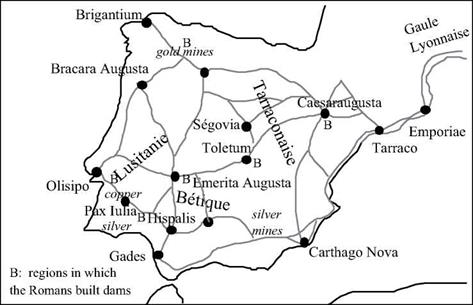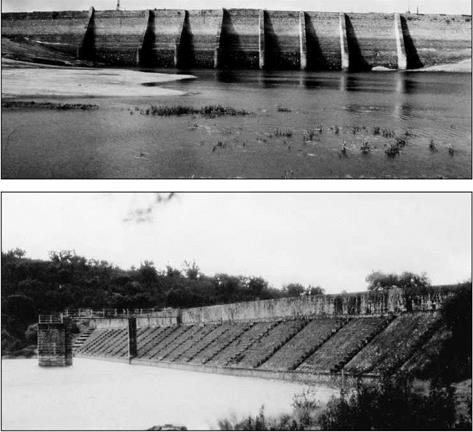Dams of the Iberian peninsula
Spain is one of the oldest Roman provinces – and it is the native province of Trajan and Hadrian. At the end of the Punic wars in 202 BC, Spain is taken by the Carthaginians, who found Cartagena (Carthago Nova). The south becomes rapidly romanized, but the pacification of the northwest is not fully achieved until 19 AD. Toward the end of the 1st century AD the conjunction of the emperor’s protection, along with generalized economic development in the western provinces and the relatively recent Roman competence in dam technology lead them to build increasing numbers of dams in the area. Today the remains of some 80 structures are known, either dams or weirs, between 1 and 19 m high and of equally variable lengths up to 700 m.[265] Most of these structures serve
|
Figure 6.27 Spain and Portugal in the Roman era. The fine lines represent Roman roads. |
|
Figure 6.28 The dams of Prosperina (above) and Cornalvo (below), near Merida (Emerita Augusta). These are among the oldest dams still in use, seen from upstream (photos by CEHOPU (CEDEX), Miguel Otero). |
the needs of irrigation as well as those of urban and industrial development.
The structures are grouped in rather well defined regions (Figure 6.27). There are nine dams around the northern metropolis of Saragossa (Caesaraugusta), and 15 around Toledo (Toletum), a city situated on the Roman road that links the north of Spain to Lusitania. But the largest number of Roman dams are in the south of the province of Lusitania: twelve around the provincial capital Merida (Emerita Augusta), both for industrial and urban water needs as well as irrigation; and another twenty or so, especially for irrigation, around the cities of Evora (Ebora), Beja (Pax Iulia), and Lisbon (Olisipo), a region of cereal production.
The three largest dams in Spain represent different techniques whose comparison is
 |
interesting (Figure 6.29).[266] The oldest of the dams is thought to be that of Alcantarilla, situated at the head of a 50-km long aqueduct that supplies the city of Toledo and crosses the valley of the Tagus through an inverted siphon. Closely associated with the city of Toledo, the dam’s history may reach back to the 2nd century BC. The structure is 14 m high and 557 m long, and comprises a fairly simple wall supported on its downstream face by buttresses and an earthen embankment to resist the water pressure. The dam failed at an unknown date, for reasons that are not difficult to imagine since debris from the wall seems to have been pushed toward the upstream. It was perhaps after a rapid emptying of the reservoir, or perhaps at a moment when the reservoir was dry and/or rainfall cut channels into the earthen embankment, that the pressure of this embankment
against the dam wall caused it to fail toward the upstream, there being no support on that side.
The two other structures, near Merida (Figure 6.28), clearly are designed to avoid this kind of accident. The dam of Prosperina, 15 m high and 426 m long, is located some 6 km north of Merida. It comprises a masonry wall supported on its downstream side by an earthen embankment like that of the Alcantarilla dam. But the Prosperina dam is also supported on its upstream side by nine thick masonry buttresses. The water intakes are accessible thanks to two shafts in the earthen embankment, right up against the dam wall itself.
The most recent of the three dams is that of Cornalvo, situated 13 km northeast of Merida. The dam is composed of an earthen dike 220 m long, and its maximum height is 20.8 m (19 m to the right of the intake). The upstream face of the dike is compartmentalized by a series of braces and protected by a revetment on its upper portion. The water intake tower, fitted with intake openings at two levels, is displaced some ten meters upstream of the dam wall, in the reservoir itself, to accommodate the upstream embankment slope. This arrangement is typically seen in modern dams.
It is difficult to assign a date to the construction of these dams. It has been proposed that Prosperina dates to the period of the reign of Trajan, around 100 or 110 AD, or 75 years after the founding of Merida. Cornalvo is thought to date from the period of Hadrian, around 120 or 130 AD. The Prosperina and Cornalvo dams are still in service today, nearly in their original state, thanks to their particularly wise design and good maintenance.








Leave a reply